Fire - the most universal cooking tool in the world. Working with flame, smoke, and temperature can create endless combinations in a dish. At Hestia, fire is the heart of the concept and our passion for exploring its use burns deep. Discover the ways we bring ancient cooking methods into the modern world, one log at a time.
Hestia: The Magic Behind the Hearth
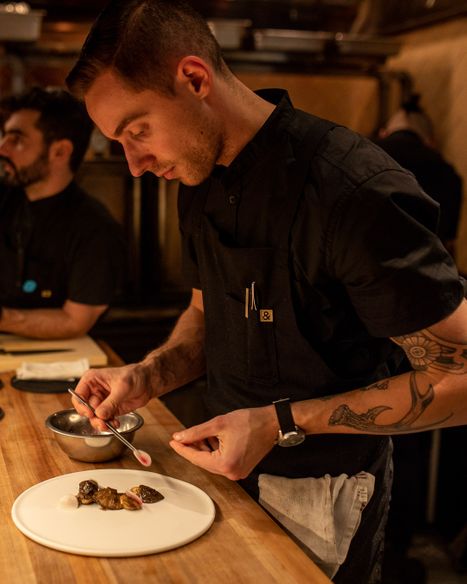
Playing with Fire
“This log won’t work.” He tells me as he shakes his head lifting another from the pile. “We don't have enough time before service to let it burn.”
He must see the look of confusion on my face because he smiles and explains.
“Feel the weight of this piece vs this one. See how it is heavier?” I nod, pretty sure I can feel the difference but not certain.
“It is too wet. This will result in what we call blue smoke, it gives a bitter and acrid smoke as the log is trying to catch fire. The color of the smoke is visibly blue hued or looks black. If we try to cook with it, the smoke will flavor the food in a way we don’t want. Instead we will try to find a log that is drier”.
Keith Rzpecki has been working with fire for a long time. He loves it and is a walking guide to historical cooking techniques and practical applications. For him and the other chefs at Hestia, fire is another ingredient. A “living” and temperamental item that can impart great flavor or ruin a dish all within a few degrees. To work at Hestia, there is a level of respect and curiosity you must have for fire.
Hestia, Goddess of the Hearth
Hestia opened in 2019 and I can remember when Kevin first described the live fire concept and how everything would showcase a technique stemming from the hearth. To be honest, I can’t say that I understood the nuances at first. To me, there was grilling and smoking and that was about it, but I could see from the excitement in his face and in the chefs around him that there was something clearly deeper.
We had the grill itself custom made, a 20 ft piece of artistry, coming from Georgia by Chris Demant. The day it arrived in the back of a U-haul it took 8 people to move the pieces inside the restaurant. They all looked like kids on Christmas. Next came the research. How did other cultures utilize fire in their cooking? What tools did they use? How could we “Tex-ify” it, make it our own?
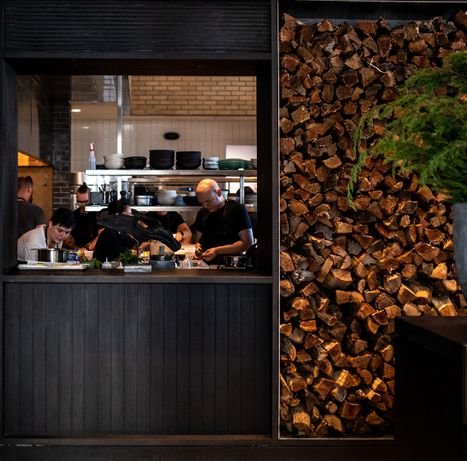
What Grows Here, Grills Here
In Texas, you can’t think of live fire without conjuring up images of good ol’ Texas Barbecue. A slow heat technique picked up from Natives by Czech and German settlers as a way to preserve leftover cuts of beef and pork. Brisket, that oh so delicious treat, was initially an undesirable cut of beef, the cross grain structure and thick cowl fat marbling made it tough and difficult to eat. However, barbecue allows that cut to be transformed by slow smoking and cooking. Of course, Texas barbecue wouldn't be what it is without Post Oak or Iron Oak.
These incredibly resilient trees grow in dry and poor soil conditions and are resistant to rot, fire and drought. Basically, it is the perfect tree in Texas and the perfect ingredient for Texas barbecue. (Just watch out for that blue smoke.)
At Hestia, while we use Post Oak 90% of the time, there are techniques where we seek out other woods for flavor. For example, in cold smoking we smoke an item without the intention of cooking it. The process only takes a few minutes as longer exposure can result in bitterness, and the temperature coming off of the smoke is less than 100 degrees Fahrenheit. By utilizing timber from Yaupon, Bay or fruit trees (such as peach or apple) we can impart a more nuanced flavor.
LIVING THE FIRE LIFE
Having a live fire restaurant means building the fire is a crucial part of our day. The first chef arrives at 7:00am each day to light the ovens. Once the coals are ready they can move to the grill. At the base of the grill there is a layer of coals from previous burned down wood and a checkmark shaped stack of two by two logs placed atop the coals. This ensures a constant amount of fire licking the bottom of the grill gate. Direct flame grilling reaches incredibly hot temperatures and most of our entrees involve a form of direct flame to sear, render fats, caramelize sugars, and add an element of char. This style of cooking is familiar to most of us, and if you have ever been on backyard grill duty you know it can be difficult to control.
Don't Sweat the Technique
Control of a living ingredient like fire is a challenge gladly accepted by the chefs at Hestia. The menu showcases the versatility of the flame while different techniques highlight one or more of its elements - flame, smoke, and temperature. Below are a few of the processes we play with:
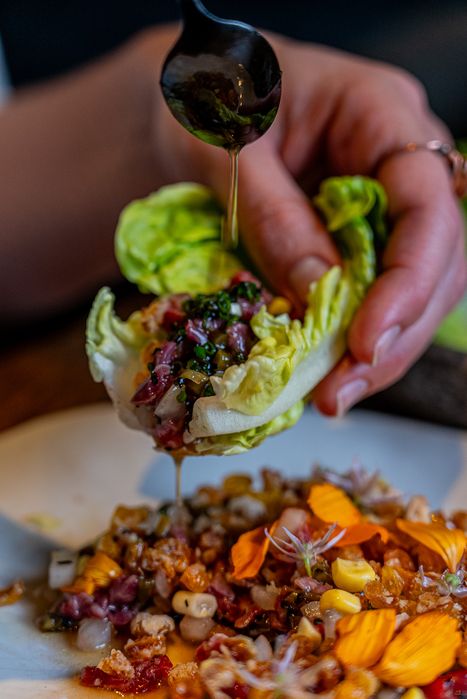
Char/Direct Grilling
Char can have an intentional place on a menu, it provides an intense bitter flavor and in small quantities it can jolt your palate back from an otherwise decadent meal. One way that we intentionally burn something is in our carpaccio. We brush the beef in beef aminos and freeze it, then we burn it in the bottom oven at around 1000 degrees. The beef is immediately cooled so the center stays completely raw. We will also dry char items before service. For this technique, we blast an item over open flame without any fat to achieve an intense grill flavor while keeping the texture alive. These dishes are often served cold to play with expectations.
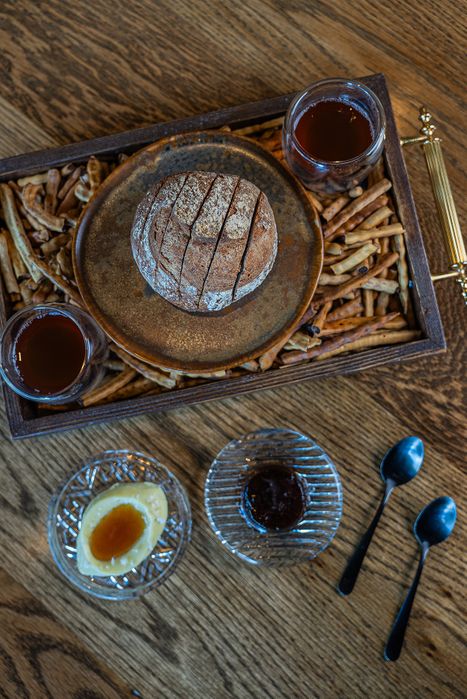
Hearth Roasting
Temperature can play a major role in menu design. Hearth Roasting involves the act of brushing something in fat and roasting it on a tray in the hearth. Aka…oven. We have three ovens in rotation, the bread oven at 350 degrees, the top oven sits at around 650 degrees and our bottom oven which sits at 1000-1200 degrees Fahrenheit during service and is used as a smoking chamber during the day.
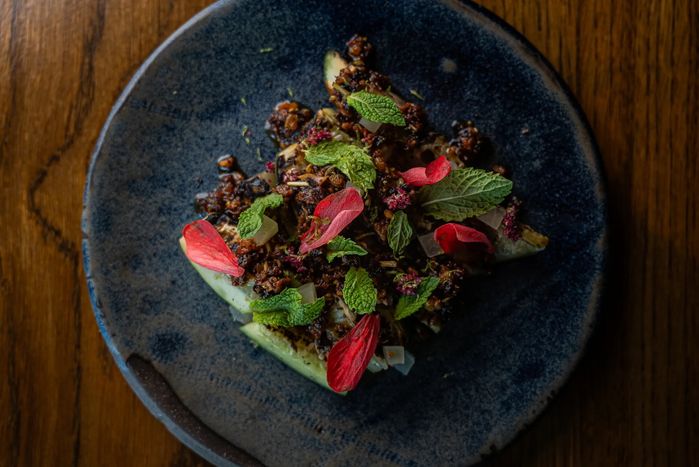
Ember Roasting
Ember roasted is when we cook directly utilizing red coals but not a direct flame. The product is placed directly on top of or buried in the coals. This technique is our favorite with fruit and vegetables, it imparts a very intense clean char flavor and very little smoke flavor. The more time with the embers the deeper the caramelization and softer the texture.
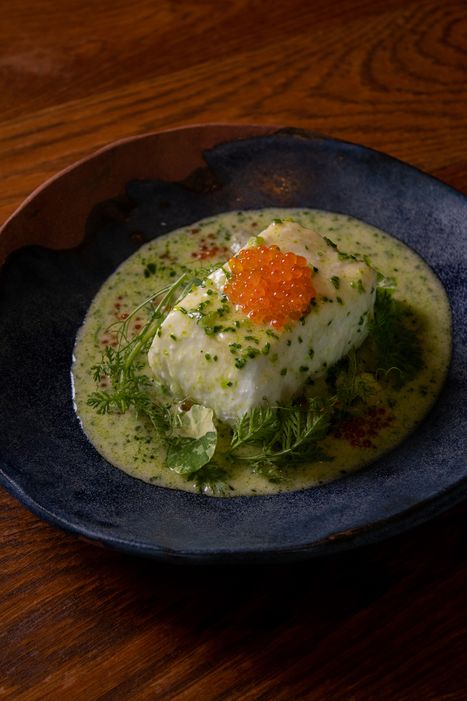
Ambient Heat
One of our iconic dishes, the halibut, is the result of ambient heat. The fish is gently rubbed in oil and rested high above the flames of the grill, typically it is sitting at 150 degrees farenheit. This low temperature means the item has to be gently rotated, think rotisserie, to achieve an even cook. The placement of the fish means that it is absorbing additional flavors from the fats and sugars carmelizing from the proteins on the direct flame two feet below.
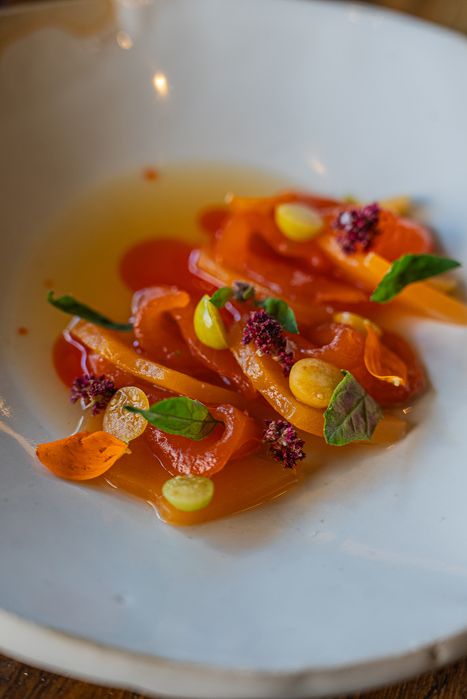
Tataki
For some items, you need both extremes of cold and hot to achieve the desired flavor and texture. One such technique is Tataki, a Japanese term where a protein is chilled down then quickly seared or torched just to cook the outside while the center is raw. Typically we will serve fish that is prepared this way by kissing it with a red hot coal over the skin, but still serving it raw. Another extreme is when we submerge red hot coals into a liquid or fat immediately extinguishing the coal. We have done this with charcoal oils, creams and butter for an incredibly aromatic result to finish a dish with.
THE FUTURE IS BRIGHT
When it comes to how to utilize the ingredient fire, the options are truly endless. Cooking on fire is nothing new to humans and it is a universal tool throughout the world. What is unique is a person’s ingenuity, ingredients and culture that has adapted fire into something new. For the past five years Hestia has been researching ways to utilize fire to create both familiar and unique dishes. The beauty is that we have just scratched the surface. Which means you get to reap the benefits of our chefs playing with fire.
